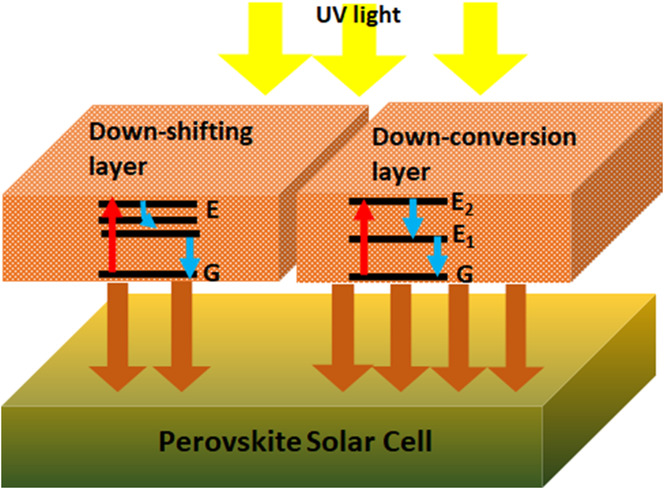An international research group has looked at how down-conversion (DC) materials could be used to improve the performance of PV cells based on perovskite. The team has found that such materials could result in an electric yield enlargement by converting ultraviolet (UV) light to visible, while also providing UV shielding.
“The DC materials can absorb the high-energy photon (300–500 nm) and re-emit a longer-wavelength photon to which the photovoltaic (PV) device is more sensitive,” the academics said. “Various types of DC materials have been investigated for this purpose like quantum dots (QDs), oxides, luminescent glasses, lanthanides, and organic dyes.”
They have argued that such materials should be used to overcome the poor blue response of solar cells, while absorbing short-wavelength light, typically in the 300 nm to 500 nm range, and re-emit it at a longer wavelength. They focused on lanthanide and non-lanthanide DC materials.
“Photoluminescence is an attractive property of lanthanides and exhibits sharp emission peaks with high color purity,” they explained.
They said that this luminescence is the outcome of the radiative and nonradiative transition of an electronically excited ion. Lanthanides are commonly used as alloys to impart strength and hardness to metals.
The DC materials could be easily doped in the charge transport or perovskite photoactive layer in order to be used to improve perovskite cells, the scientists said. They should have dual-functional properties to facilitate charge carrier transport.
“Most of the lanthanide DC material synthesis processes required high temperature, and also their material availability on Earth are limited, which restrict them for future applications,” the group said. “The development of nonlanthanide DC materials can be an approach for future cost-effective device applications.”
They described their findings in “Downconversion Materials for Perovskite Solar Cells,” which was recently published in RLL Solar. The team includes scientists from Swansea University in the United Kingdom, the Khalifa University of Science and Technology in the United Arab Emirates, the CSIR-National Physical Laboratory and the University of Jammu in India, and the Indian Institute of Technology.
“This review may allow researchers working on the PSCs to develop more photostable devices and consequently help in future commercialization in an increasingly green energy market,” the scientists said. “Future focus will also be on utilizing the whole incoming spectrum from IR to UV in photovoltaic devices.”
This content is protected by copyright and may not be reused. If you want to cooperate with us and would like to reuse some of our content, please contact: editors@pv-magazine.com.




2 comments
By submitting this form you agree to pv magazine using your data for the purposes of publishing your comment.
Your personal data will only be disclosed or otherwise transmitted to third parties for the purposes of spam filtering or if this is necessary for technical maintenance of the website. Any other transfer to third parties will not take place unless this is justified on the basis of applicable data protection regulations or if pv magazine is legally obliged to do so.
You may revoke this consent at any time with effect for the future, in which case your personal data will be deleted immediately. Otherwise, your data will be deleted if pv magazine has processed your request or the purpose of data storage is fulfilled.
Further information on data privacy can be found in our Data Protection Policy.